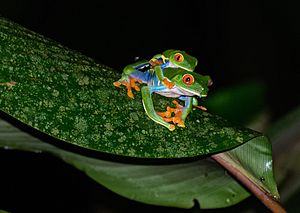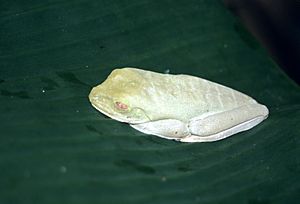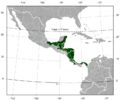Red-eyed tree frog facts for kids
- For the Australian species also known as the red-eyed treefrog, see Ranoidea chloris
Quick facts for kids red eye tree frog |
|
|---|---|
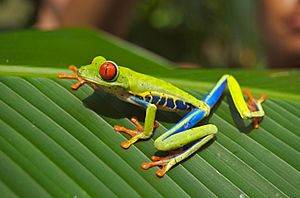 |
|
| Conservation status | |
| Scientific classification | |
 |
|
| Red-eyed Treefrog range | |
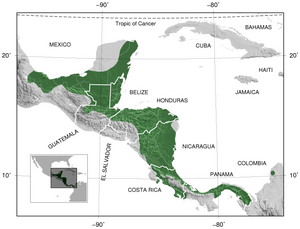 |
|
| Larger scale | |
| Synonyms | |
|
The red-eyed treefrog (scientific name: Agalychnis callidryas) is a colorful frog that lives in trees. Its scientific name comes from Greek words meaning "beautiful tree nymph." These frogs are found in the Neotropical rainforests. Their home stretches from Mexico through Central America all the way to Colombia. Sometimes, people keep these amazing frogs as pets.
Contents
About the Red-Eyed Treefrog
Red-eyed treefrogs are known for their large, bright red eyes. Their pupils, the black part in the middle of the eye, are shaped like thin lines. These frogs are very colorful! They have a bright green body with yellow and blue stripes on their sides. Their belly is white, and their feet are a bright orange or red.
They have special sticky pads on their toes. These pads help them cling tightly to leaves and branches. The skin on their belly is soft and thin. However, the skin on their back is thicker and a bit rougher. Male red-eyed treefrogs are usually about two inches long. Females are a little bigger, growing to about three inches.
Where Red-Eyed Treefrogs Live
Red-eyed treefrogs live near rivers and ponds in rainforests. They prefer warm, humid places. You can find them in lowlands on the Atlantic side of Central America. This area goes from southern Mexico down to central Panama and northern Colombia. They also live on the Pacific side in parts of Nicaragua and Costa Rica.
These frogs like temperatures between 24 to 29 degrees Celsius during the day. At night, they prefer it to be 19 to 25 degrees Celsius. They also need a lot of moisture in the air, at least 80% humidity.
How Red-Eyed Treefrogs Behave
Red-eyed treefrogs spend most of their lives in trees. They are excellent at jumping from branch to branch. Even though they are very colorful, these frogs are not poisonous. They use their bright colors and clever tricks to stay safe from predators.
They are nocturnal, which means they are active at night. During the day, they sleep. To hide, they tuck their bright feet under their bellies. They also cover their blue sides with their back legs. Then, they close their red eyes. This makes them look almost completely green, helping them blend in with the leaves.
Red-eyed treefrogs have a special clear eyelid called a Nictitating membrane. This membrane lets light into their eyes even when they are "sleeping." This helps them wake up if a predator is near. Their big red eyes also help them see at night. They use their eyes to scare away predators too! If a frog senses danger, it suddenly opens its bright red eyes. This sudden flash of color can startle the predator, giving the frog time to jump away to safety.
What Red-Eyed Treefrogs Eat
Red-eyed treefrogs are insectivores, meaning they eat insects. Their diet includes crickets, moths, grasshoppers, and flies. Sometimes, they might even eat smaller frogs. Baby red-eyed treefrogs, called tadpoles, mostly eat tiny insects like fruit flies.
Red-Eyed Treefrog Life Cycle and Reproduction
When it's time to lay eggs, the female frog chooses a leaf. This leaf is usually found hanging over a pond or a large puddle. She lays about 40 eggs in a group, called a clutch. Red-eyed treefrogs often fold the leaf around their eggs. This helps hide them from animals that might want to eat them. They also make a sticky jelly to hold the eggs together. This jelly protects the eggs from drying out.
The eggs develop into tadpoles. After about six to seven days, the tadpoles hatch. They then fall into the water below. Red-eyed treefrog embryos use the natural day and night light cycles to know when to hatch. They usually hatch just after nightfall.
Sometimes, red-eyed treefrog eggs hatch early if they sense danger. This is called phenotypic plasticity. For example, if predators like dragonflies or fish are nearby, the eggs might hatch sooner. If the eggs are drying out, they might also hatch early. This helps the tadpoles escape danger and get into the water.
Tadpoles stay in the water for a few weeks to several months. During this time, they grow and change into frogs. This change is called metamorphosis. After metamorphosis, their bodies change from green to brown. Their eyes, which were yellow, turn a deep red. These changes mean they are becoming mature. Red-eyed treefrogs can live for about five years.
Young frogs that survive their first few weeks move into plants near their birth ponds. They often hide in hollow plants like bromeliads. Young frogs eat very small flies and other insects. They become mature and start mating when they are about two to four years old.
In captivity, these frogs can breed successfully. They need a humid environment with tropical plants and clean water. Simulating a rainy season can encourage them to reproduce.
How Embryos Adapt to Danger
Red-eyed treefrog embryos can hatch early to protect themselves. This is a special ability called phenotypic plasticity. Normally, eggs hatch after 6 to 10 days. But if the eggs are in danger, they can hatch much sooner.
For example, if predators like snakes, monkeys, or even certain fungi are close, the embryos can feel the vibrations. After a few seconds, the embryos will quickly hatch into tadpoles. They then spread out to escape the danger. Since the eggs are usually laid above water, the tadpoles often fall directly into the pond. If they fall onto dry ground, they can survive for up to 20 hours without water. This amazing ability helps them survive in a dangerous world.
Protecting Red-Eyed Treefrogs
The IUCN says that the red-eyed treefrog is a species of "Least Concern." This means they are not currently in danger of disappearing. They are found in many places and have large populations. Many of these areas are protected.
However, red-eyed treefrogs still face some challenges. Their homes are sometimes destroyed due to deforestation. Also, some are collected to be sold as pets. Protecting their rainforest homes is important for their future.
Related Animals
- Orange-eyed tree frog, another type of tree frog found in eastern Australia.
Images for kids





